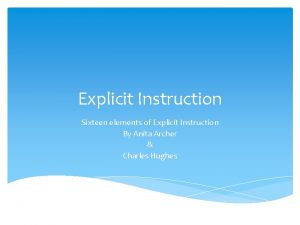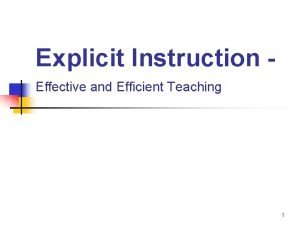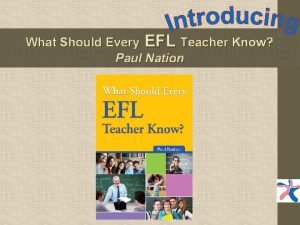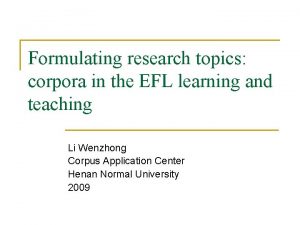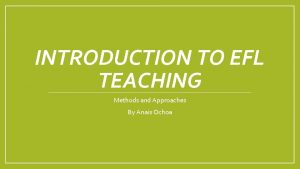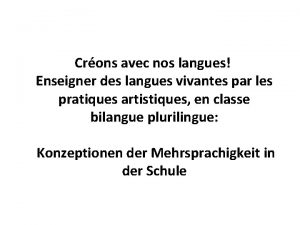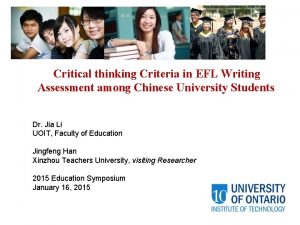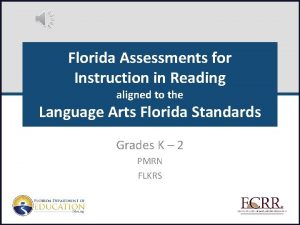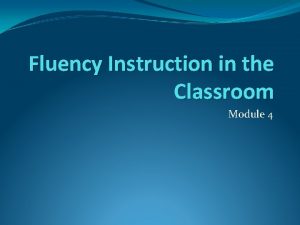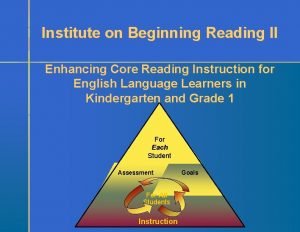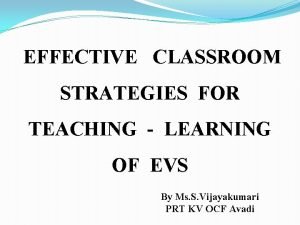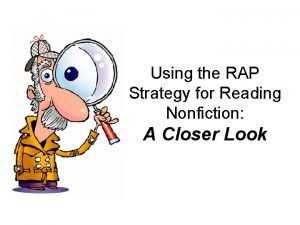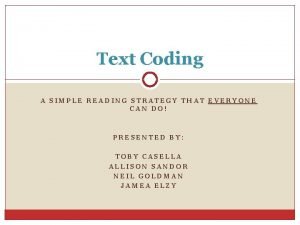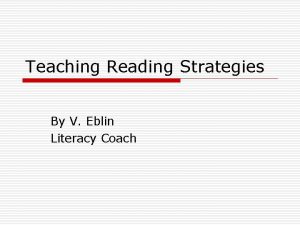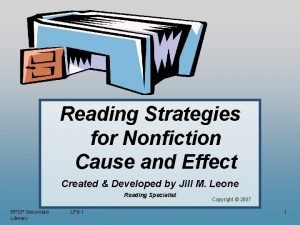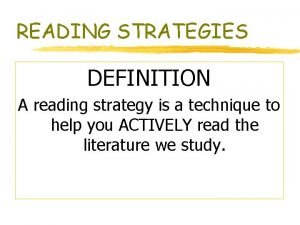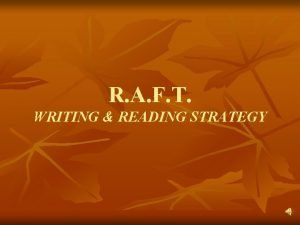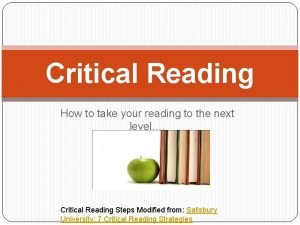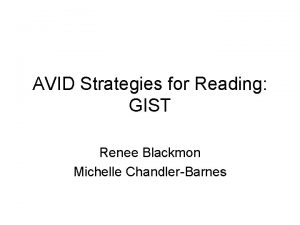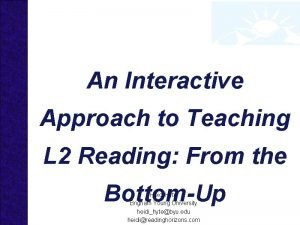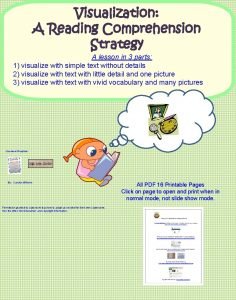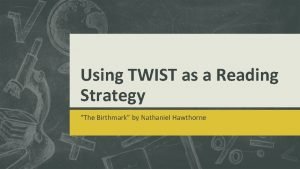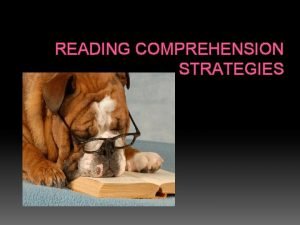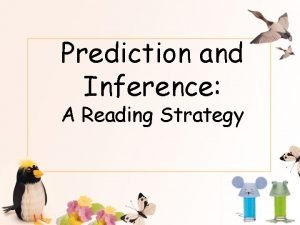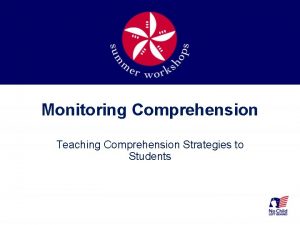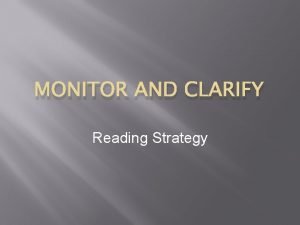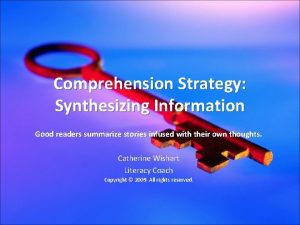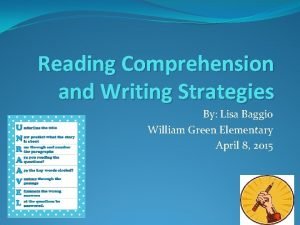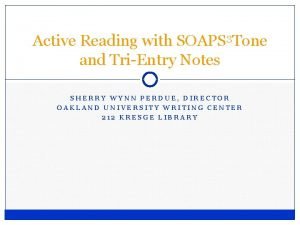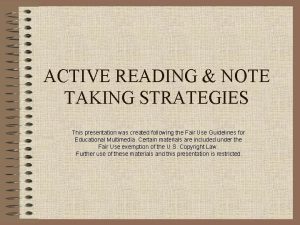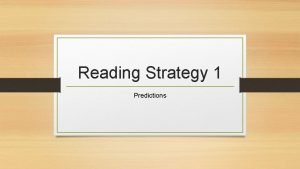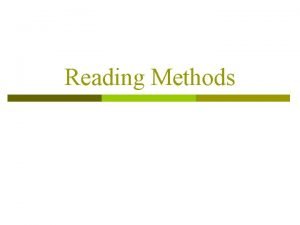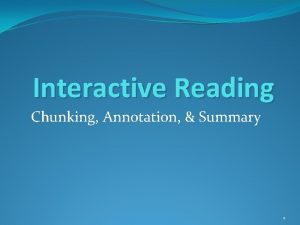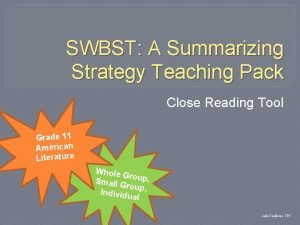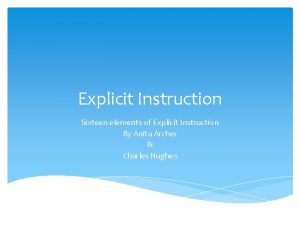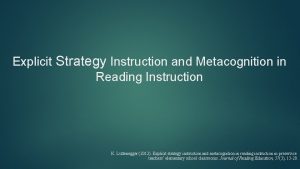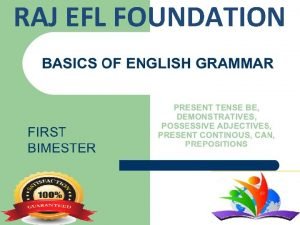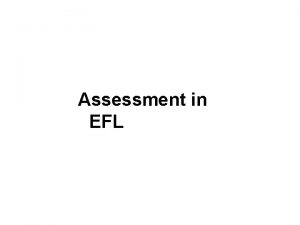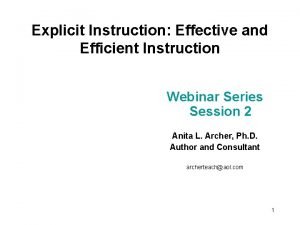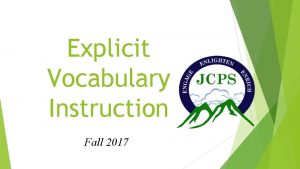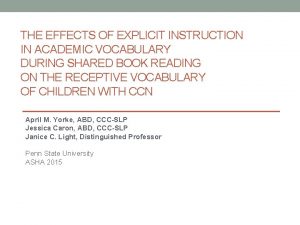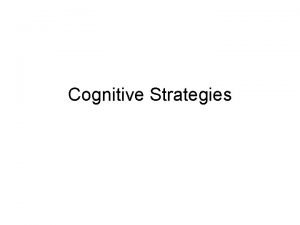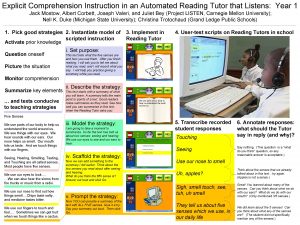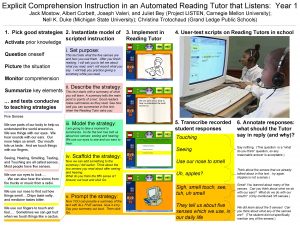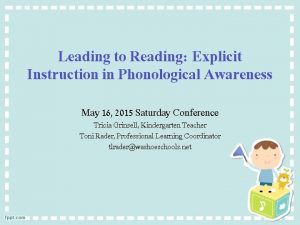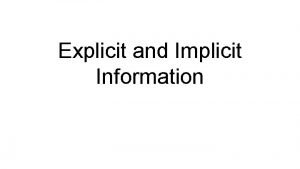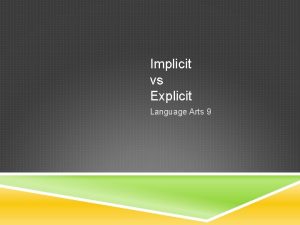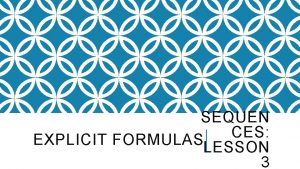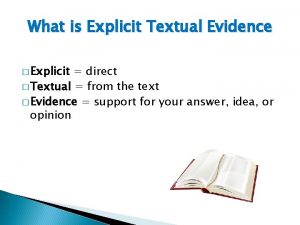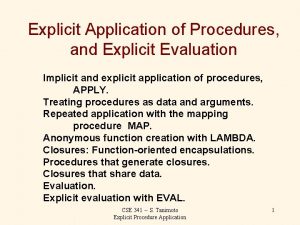Effects of Explicit Reading Strategy Instruction on EFL









































































- Slides: 73

Effects of Explicit Reading Strategy Instruction on EFL Learners’ Reading Anxiety Researcher: 李秋美 Advisor: 鍾榮富 教授 Reporter: 哀宛君 Judy Ai (NA 2 C 0013)

Introduction Background and Motivation Purposes of the Study Research Questions Significance of the Study Limitations of the Study Definition of Terms

Background and Motivation-1 Reading is supposed to be a very pleasant leisure activity; however, some students reported experiencing anxiety and fear while they were left to confront lengthy articles and required to answer relevant reading questions. Grammar-translation approach is still a dominant teaching method in the English learning settings of Taiwan ( Chen, 2005). There is little time for the teaching of reading strategies to enhance students’ reading comprehension. As Krashen (1982) proposed in his affective filter hypothesis, the learners’ emotional state is the main factor which would form an affective filter to block away input data. Moreover, he suggested that mental block and uneasy feelings could disturb a second language acquisition process.

Background and Motivation-2 Among the four skills, listening and speaking are most associated with foreign language anxiety; however, reading is the most important skill that students should master due to the test-oriented English learning context of Taiwan. It is a pity that no recent research with a focus on reading anxiety took senior high school students as participants. Therefore, much room is left for further investigation into reading anxiety of EFL senior high students. (niche ) With respect to making reading less stressful, strategy-oriented approach to reading is among one of the techniques proposed by Horwitz (1986) to help “allay students’ anxiety” (p. 35). Kern (1988) also suggested incorporating explicit strategy instruction into FL learning.

Background and Motivation-3 Tierney, Readence and Dishner (1995) described, through the explicit teaching of reading comprehension, students could develop their reading comprehension skills and strategies that could be applied to other reading situations without teacher support. In Taiwan, several studies were conducted to explore the effects of reading strategy instruction at all school levels. However, none of the above studies aimed to investigate how students’ reading anxiety was influenced or reduced by explicit comprehension instruction. (niche ) The researcher feels motivated to explore the factors affecting students’ reading anxiety, and the practicability and effectiveness of incorporating explicit comprehension instruction into the regular English class.

Purposes of the Study To investigate the causes of EFL senior high school first-graders’ reading anxiety To examine the effects of the explicit instruction of reading strategies on their reading anxiety and reading comprehension To find out whether the strategy instruction is effective in improving students’ ability to answer different patterns of multichoice reading questions To explore students’ acquisition and adoption of those reading strategies and their responses to the reading strategy training

Research Questions What are the major causes of EFL senior high school students’ reading anxiety? Does the explicit strategy instruction reduce EFL senior high school students’ reading anxiety? Does the explicit strategy instruction facilitate EFL senior high school students’ reading ability, including identifying main ideas, searching for detailed information, drawing logical inferences and deriving contextual meanings of unfamiliar words? What are EFL senior high school students’ responses to the explicit strategy instruction?

Significance of the Study-for teachers They may have a deeper understanding of students’ reading anxiety and problems, and therefore feel motivated to make a change or an adjustment in their reading instruction. They may consider the possibility of incorporating the explicit instruction of reading strategies in their reading instruction programs to help students read with less anxiety and more efficiency. They can examine whether students are able to apply their acquired strategies to reading comprehension tests. They can gain a clear understanding of students’ responses to the strategy training and students’ attitudes toward English reading after the intervention.

Significance of the Study-for students ~ especially for those who have long been struggling with unpleasant English reading experience ~ The instruction can inform them of the existence and application of reading strategies. The instruction can encourage them to independently make flexible use of the acquired strategies in reading tests or real reading situations.

Limitations of the Study Since the subjects involved in this study are only 84 male freshman students at a senior high school in southern Taiwan, the generalization of this study is limited. Only five reading strategies are chosen for the experiment due to the time limit of 15 weeks. Therefore, students’ knowledge and application of other reading strategies are not investigated. Due to the short period of training time, students’ retentive use of the instructed strategies in their reading processes over a longer period of time is not further explored. Consequently, the long-term effectiveness cannot be determined. The assessments of students’ reading proficiency are restricted to multiple-choice questions. Thus, students’ overall reading comprehension can not be tested with multiple instruments.

Definition of Terms-1 Foreign language anxiety Horrwitz et al. (1986) defined foreign language anxiety as “a distinct complex of self-perception, belief, feelings, and behaviors related to classroom language learning arising from the uniqueness of the language learning process” Foreign language reading anxiety It is defined as any discomfort or fear accompanied by reading foreign texts during reading process or in a testing condition.

Definition of Terms-2 Explicit comprehension instruction It refers to the instruction of reading strategies in an explicit: (Beckman, 2002) Describing the strategy and its purpose Modeling its use and explaining to the students how to perform it Providing ample assisted practice time - monitoring, providing clues, and giving feedback Promoting student self-monitoring and evaluation of personal strategy use Encouraging continued use and generalization of the strategy in independent learning situations

Definition of Terms-3 Top-down processing In top-down processing, readers use background knowledge to make predictions, and then search the text to confirm or reject the predictions that were made. They begin with meaning and then move down to words (Ko, 2004) Bottom-up processing The bottom-up processing consists of lower-level reading processes -letters, letter clusters, words, phrases, sentences, longer text, and finally meaning. (Anderson, 2003) Interactive processing The readers continually shifted from one focus to another in the process of reading, adopting a top-down approach to predict the probable meaning, then moving to the bottom-up approach to verify whether the prediction was what the writer meant.

Literature Review Affective Variables in Foreign Language Learning Foreign Language Reading Anxiety Reading Strategies Explicit Comprehension Instruction

Affective Variables in Foreign Language Learning-1 Affective Filter Hypothesis (Krashen, 1982) According to Krashen, emotions act as a filter that controls whether language is allowed to flow into the language-learning system in the brain. The best acquisition would occur in contexts where the affective filter was low. When the learner was anxious and lacked self-confidence, the filter was up and the acquisition or comprehension would be reduced. However, he commented, “There is something called facilitative anxiety. My hypothesis is that facilitative anxiety has a positive effect on language learning.

Affective Variables in Foreign Language Learning-2 Foreign Language Classroom Anxiety Scale (Horwita, 1986) Horwitz developed FLCAS in an effort to identify and measure the concept of foreign language. There are three major components of foreign language anxiety in the scale. Communication apprehension A type of shyness characterized by fear of or anxiety about communicating with people negative evaluation The worry about others’ evaluation, the tendency to avoid evaluative situations, and the expected feelings of others’ negative evaluation test anxiety A type of performance anxiety stemming from a fear of failure and it is concerned with apprehension over academic evaluation

Affective Variables in Foreign Language Learning-3 Foreign Language Anxiety in 3 -stage Model of Learning (Tobias, 1979) Input Anxiety acts like a filter preventing some information from getting into the cognitive processing system. Processing Anxiety acts as a distraction, disabling students to learn new words, phrases, grammar, and so on. Output Anxiety can influence the quality of second language communication. The effect can be observed when speaking or writing.

Foreign Language Reading Anxiety-1 Saito, Garza and Horwitz (1999) introduced the construct of foreign language reading anxiety. The conducted a study to investigate foreign language reading anxiety among foreign language students. ◎ Participants- 383 university students who enrolled in first semester course of French, Japanese and Russian ◎ Instruments- Foreign Language Classroom Anxiety Scale (FLCAS) (Horwitz, 1986) Foreign Language Reading Anxiety Scale (FLRAS) (Saito, 1999) The study found that reading in FL can be anxiety provoking to some students. They also provided the existence of foreign language reading anxiety as a phenomenon related to but distinguished from general foreign language anxiety.

Foreign Language Reading Anxiety-2 Unfamiliar Linguistic Features Unfamiliar Cultural Materials Lack of Sufficient Prior Knowledge Sources of Foreign Language Reading Anxiety Limited Reading Proficiency Low Self-Efficacy Misconceptions about Reading

Foreign Language Reading Anxiety-3 Ø Unfamiliar Linguistic Features- Linguistic features, including foreign writing systems, vocabulary and syntactic knowledge, arouse immediate reading anxiety. Ø Unfamiliar Cultural Materials- Anxiety is also anticipated when a reader realizes that the words he or she decoded do not constitute a comprehensible or logical message entity because of incomplete knowledge of the cultural materials underlying the text. Ø Lack of Sufficient Prior Knowledge- Readers comprehend something new by relating it to the past experience, background knowledge, or more technically -schemata. Ø Limited Reading Proficiency- Frustration and uneasiness are associated with anxiety; accordingly, it is anticipated that anxiety may occur when readers try to make meanings out of the passage but failed. Ø Low Self-Efficacy- Self-efficacy can be generally defined as pesonal beliefs in one’s capabilities. Much of the language learners’ anxiety comes from the threat to the learners’ self-concept of competence.

Foreign Language Reading Anxiety-4 Ø Misconceptions about Reading- Lee (1999) hypothesized that misconceptions about reading can lead to learner anxiety. Successful reading equals answering comprehension questions. Reading is a private act that takes place outside the classroom by an isolated reader. Reading is a linear process that begins with the first word on the page and proceeds directly to the last word on the page. Comprehension is an absolute.

Reading strategies-1 Selected Reading Strategies Identifying the Text Structure Text structure generally refers to how the ideas in the text are interrelated to convey a message to the reader (Chen, 2005). Awareness of text structure is useful in helping readers comprehend texts more easily. Skimming for the Topic and Main Idea Skimming is a specific reading technique necessary for quick and efficient reading (Grellet, 1981). Skimming is high-speed, purposeful skipping that can save readers lots of time.

Reading strategies-2 Scanning for Details Scanning is looking quickly and selectively through the text for a specific piece of information such as name, date, or number. This skill helps readers skip unimportant words, so that they can read faster (Grellet, 1981; Mikulecky & Jeffries, 1996; Miller & Orozco, 2001; Sotiriou &Phillips, 2000). Drawing Inferences Making inferences effectively may bring four primary positive outcomes (Borne et al. , 2004) - leads to better overall comprehension - leads to more engagement with text - makes sophisticated reader - helps reader be metacognitive

Reading strategies-3 Deriving Word Meaning in Context Smith (1971) argued that the best way to identify an unfamiliar word in a text was to draw inferences from the rest of the text rather than looking it up in the dictionary. Through utilization of contextual information to guess word meaning, the reader’s attention can remain on the text and the possibility of interrupting the reading process, such as looking up words in the dictionary, can be reduced.

Explicit Comprehension Instruction-1 Explicit Explanation The teacher explains and the class discusses why learning and practicing strategies are important. Teacher Modeling Teachers explain the mental reasoning involved in performing various reading tasks. Teacher thinkaloud is typically conceived of as an effective form of teacher modeling.

Explicit Comprehension Instruction-2 Guided Practice The teacher first explains how to use the strategy and then gives students more and more independence in practicing and applying the strategy over time. Independent Application As readers accept full responsibility for making sense of the texts, they begin to use these strategies and practices independently.

Explicit Comprehension Instruction-3

Methodology Participants Instruments Study Procedures Data Aanalysis

Participants Item Content School Kaohsiung Municipal Senior High School Grade First-grade Age Numbers The average of 16 84 from 2 classes of equal English proficiency (mean scores of the first monthly exam, t =. 383, p >. o 5) Gender Male Groups Based on the responses to the Chinese version of FLRAS High-anxiety- 22, mean scores were top 27% (68 -88) Low-anxiety- 22, mean scores were bottom 27% (35 -55) Mid-anxiety- 40, the rest (56 -67)

Instruments-1 Materials for Instructing Each Reading Strategy — Book One of Nan-I Senior High School English Textbook — Articles in English learning magazines and newspapers — Drills in exercise books concentrating on training reading skills — Handouts and worksheets edited according to Duke and Pearson’s (2002) model of explicit comprehension instruction * Part A — Explanation * Part B — Modeling * Part C — Guided practice * Part D — Independent practice

Instruments-2 Reading Comprehension Test (RCT) — 30 multiple-choice reading questions, with four reading passages from the college entrance examinations (CEE) of the academic year of 94, 95, 96 and 98, five passages from the GEPT Intermediate Level Test, which were published by The Language Training & Testing Center — The possibility that students might have had access to those test question was excluded * All the subjects were freshman students. * None of those who had passed the GEPT Intermediate Level Tests (6) had taken exactly the same test questions.

Instruments-3 Reading Comprehension Test (RCT) — Prior to selecting reading passages for tests, students’ reading ability should be taken into serious account. Therefore, the researcher randomly chose 6 texts from students’ textbook and computed the readability grade level according to Fry’s readability formula ( 1968 ) — The researcher categorized the 30 question items into four types. * main idea questions * detail questions * inference questions * word-in-context questions


Instruments-4 Foreign Language Reading Anxiety Scale (FLRAS) — The FLRAS designed by Saito, Horwitz and Garza (1999) was used. — The Chinese version of the scale, which modified the statements by Huang (2001), was administered to the subjects. — The FLRAS consisted of 20 items, and each was answered with a five-point Likert-type scale. * negative statements (5 4 3 2 1) * positive statements, such as item 12, 13, 14, 18 ( 1 2 3 4 5 )

Instruments-5 The Questionnaire (QSRERSI) QSRERSI The Questionnaire on Students’ Responses toward the Explicit Reading Strategy Instruction five- level agreement scale (21) 。 Students’ acquisition of the instructed strategies ( 1 -5 ) 。Students’ fondness for the strategy instruction ( 6 -7) 。 Students’ feedback to teaching method and materials ( 8 -13) 。 Students’ evaluation of the effectiveness of the strategy instruction (14 -16) 。 Students’ application of the instructed strategies in tests (17 -21) two open questions 。 Students’ comments about the benefits of receiving the strategy instruction 。Students’ comments the difficulties they encountered in the training process

Study Procedures Phase 1: Recruiting forty-two students excluded from the experiment to answer the Chinese version of the FLRAS in the pilot study Phase 2: Revising and adjusting the pilot FLRAS Phase 3: Asking the eighty-four subjects to take the FLRAS and the RCT Phase 4: Instructing the five selected reading strategies for 10 weeks Phase 5: Guiding the subjects to practice the instructed reading strategies in combination for 2 weeks Phase 6: Encouraging the subjects to apply their strategies in independent reading situations for 3 weeks Phase 7: Asking the subjects to answer the post-test QSRERSI, answer the FLARS again, and take the RCT again Phase 8: Collecting, computing, and analyzing the data

Data Analysis Quantitative Analyses SPSS: ★ paired-samples t-test -to see if any significant differences in the subjects’ reading anxiety and reading comprehension were related to the explicit reading strategy instruction ★ paired-samples t-test -to compare students’ pre-test and post-test scores of each question pattern ★ eta squared statistics - to compare the magnitude of intervention’s effect on (1) students with different levels of reading anxiety (2) the scores of different question pattern ★ frequencies and percentages - to see how the students responded to the explicit reading strategy instruction in the post-test questionnaire e Qualitative Analyses The qualitative analysis was used to examine the open-ended questions in the questionnaire.

Results & Discussions Major Causes of EFL Students’ Reading Anxiety Effects of the Strategy Instruction on Students’ Reading Comprehension Students’ Responses to the Strategy Instruction

Major Causes of EFL Students’ Reading Anxiety-1 Limited reading proficiency Item Mean 1. I get upset when I’m not sure whether I understand what I am reading in English. 3. 69 3. When I’m reading English, I get so confused I can’t remember what I’m reading 3. 25 Lack of sufficient prior knowledge Item 5. I am nervous when I am reading a passage in English when I am not familiar with the topic. Mean 3. 21

Major Causes of EFL Students’ Reading Anxiety-2 Unfamiliar linguistic feature Item Mean 6. I get upset whenever I encounter unknown grammar when reading English. (grammar) 3. 19 7. When reading English, I get nervous and confused when I don’t understand every word. (vocabulary) 3. 52 9. I usually end up translating word by word when I’m reading English. (vocabulary) 3. 57 10. By the time you get past the funny letters and symbols in English, it’s hard to remember what you’re reading about. (writing system) 3. 40 11. I am worried about all the new symbols I have to learn in order to read English. (writing system) 3. 20

Major Causes of EFL Students’ Reading Anxiety-3 Reading experience Item Mean 12. I enjoy reading English. 3. 09 13. I feel confident when I am reading English. 3. 34 17. I don’t mind reading to myself, but I feel very uncomfortable when I have to read English aloud. 3. 08 Low self-efficacy of reading competence Item 18. I am satisfied with the level of reading ability in English that I have achieved so far. Mean 3. 92

Effects of the Strategy Instruction on Students’ Reading Anxiety-1 Comparisons of the Causes of Reading Anxiety Concerning Limited Reading Proficiency Between Pre-test and Post-test

Effects of the Strategy Instruction on Students’ Reading Anxiety-2

Effects of the Strategy Instruction on Students’ Reading Anxiety-3 Comparisons of the Cause of Reading Anxiety Concerning Lack of Sufficient Prior Knowledge Between Pre-test and Post-test

Effects of the Strategy Instruction on Students’ Reading Anxiety-4 Comparisons of the Causes of Reading Anxiety Concerning Unfamiliar Linguistic Features Between Pre-test and Post-test

Effects of the Strategy Instruction on Students’ Reading Anxiety-5

Effects of the Strategy Instruction on Students’ Reading Anxiety-6

Effects of the Strategy Instruction on Students’ Reading Anxiety-7 Comparisons of the Causes of Reading Anxiety Concerning Reading Experience Between Pre-test and Post-test

Effects of the Strategy Instruction on Students’ Reading Anxiety-8

Effects of the Strategy Instruction on Students’ Reading Anxiety-9 Comparisons of the Cause of Reading Anxiety Concerning Low Self-Efficacy of Reading Competence Between the Pre-test and Post-test

Effects of the Strategy Instruction on Students’ Reading Comprehension-1 Means, Standard Deviations, and Comparisons of RCT Pre-test and Post-test Scores * 30 multiple-choice questions with one point for each Measure N M SD Pre-test 84 17. 84 4. 95 t-value -8. 817*** Post-test 84 21. 10 4. 49 p . 000

Effects of the Strategy Instruction on Students’ Reading Comprehension-2 Means, Standard Deviations, Comparisons and Eta Squared of RCT Pre-test and Post-test Scores of Each Group Measure N M Pre-test 22 15. 45 SD Post-test 22 19. 36 4. 11 Pre-test 40 17. 52 4. 09 MRAG Post-test 40 20. 92 4. 66 Pre-test 22 20. 81 5. 26 LRAG 22 23. 18 p Eta squared -7. 374*** . 000 0. 65 -6. 333*** . 000 0. 58 -2. 727*** . 013 0. 20 4. 75 HRAG Post-test t-value 3. 86

Effects of the Strategy Instruction on Students’ Reading Comprehension-3 Means, Standard Deviations, Comparisons and Eta Squared of the Pre-test and Post-test Mean Scores of Each Question Pattern Measure Main Idea Pre-test N M SD 4. 01 1. 653 7 Questions Post-test 4. 86 1. 437 Detail Pre-test 7. 03 2. 500 12 Questions Inference Post-test 8. 53 2. 402 Pre-test 4. 02 1. 202 6 Questions Word-in-Context Post-test 4. 58 1. 121 Pre-test 2. 72 . 998 5 Questions Post-test 3. 11 1. 079 t-value p Eta squared -5. 563*** . 000 0. 51 -7. 665*** . 000 0. 66 -4. 252*** . 000 0. 38 -2. 922** . 004 0. 22

Students’ Responses to the Strategy Instruction-1 Frequencies and Percentages of Students’ Responses to Their Acquisition of the Instructed Strategies

Students’ Responses to the Strategy Instruction-2

Students’ Responses to the Strategy Instruction-3 Frequencies and Percentages of Students’ Fondness for the Strategy Instruction

Students’ Responses to the Strategy Instruction-4 Frequencies and Percentages of Students’ Responses to the Teaching Method and Materials

Students’ Responses to the Strategy Instruction-5

Students’ Responses to the Strategy Instruction-6 Frequencies and Percentages of Students’ Evaluation of the Effectiveness of the Strategy Instruction

Students’ Responses to the Strategy Instruction-7 Frequencies and Percentages of Students’ Responses to Their Reading Strategy Application in Tests

Students’ Responses to the Strategy Instruction-8

Students’ Responses to the Strategy Instruction-9 Students’ Responses to the First Open Question

Students’ Responses to the Strategy Instruction-10 Students’ Responses to the First Open Question

Students’ Responses to the Strategy Instruction-11 Students’ Responses to the Second Open Question

Conclusions, Implications, and Suggestions Conclusions Pedagogical Implications Suggestions for Future Research

Conclusions-1 RQ 1 What are the major causes of EFL senior high school students’ reading anxiety? ★ Limited reading proficiency (2 items) ★ Lack of sufficient prior knowledge (1 item) ★ Unfamiliar linguistic features (5 items) ★ Reading experience (3 items) ★ Low self-efficacy of reading competence (1 item)

Conclusions-2 RQ 2 Does the explicit strategy instruction reduce EFL senior high school students’ reading anxiety? ★ For the HRAG, anxiety level differences of 10 items from the pre-test to the post-test showed significance, for the MRAG 8, and for the LRAG 2. ★ Both the high-anxiety group and the mid-anxiety group benefited much from the strategy instruction, but the low-anxiety group gained comparatively less benefits. ★ A total of 20 significant differences between the pre-test and post-test mean scores indicated the positive effect of reading strategy on eliminating students’ reading anxiety, especially those with a higher level of reading anxiety.

Conclusions-3 RQ 3 Does the explicit strategy instruction facilitate EFL senior high school students’ reading ability, including identifying main ideas, searching for detailed information, drawing logical inferences and deriving contextual meanings of unfamiliar words? ★ As a whole, students’ English reading comprehension development was significantly improved after the reading strategy training. Students with higher levels of reading anxiety benefited more from the strategy instruction than those with lower levels of reading anxiety. ★ The strategy instruction did help enhance the subjects’ ability to identify main ideas, search for detailed information, draw logical inferences and derive contextual meanings of unfamiliar words. Besides, the eta squared values revealed that the strategy of deriving word meanings from context was regarded as the most difficult strategy to command.

Conclusions-4 RQ 4 What are EFL senior high school students’ responses to the explicit strategy instruction? ★ A majority of subjects had a positive response toward the explicit strategy instruction. ★ Students still felt uncertain about their ability to guess word meaning in context even though their post-test reading test score on the word-in-context question type was significantly improved.

Pedagogical Implications 1. Effective reading instruction focusing on making reading less stressful should be taken into serious consideration. 2. EFL teachers should merge the strategy training with their regular curricular activities over an extended period of time. 3. Students’ fear of public evaluation should be taken into consideration. 4. Teachers should choose materials or texts which coincide with the students’ linguistic competence. 5. 5. Reading materials with contents of students’ interest should be provided to excite student to read.

Suggestions for Future Research 1. Larger groups of participants 2. A control group 3. A longer period of time about the strategy instruction 4. A regular follow-up tracking 5. Investigation into determining whethere are positive aspects to anxiety in the FL learning context, and what degree of reading anxiety can contribute to reading performance 6. Studies to examine whether participants in different reading-anxiety groups respond differently to the questionnaire 7. Interviews with the subjects and think-aloud protocol

The Investigate the Major Causes of My Students’ English Reading Anxiety Group Item 84 male (senior) 1, 3, 5, 6, 7, 9, 10, 11, 12, 13, 17, 18 37 male (senior) 1, 3, 5, 6, 9, 10, 11, 13, 17, 18 17 female (senior) 1, 4, 5, 6, 9, 10, 11, 12, 13, 17, 18 29 male (junior) A 1, 5, 6, 10, 11, 12, 13, 17, 18 20 female (junior) A 1, 6, 10, 18 33 male (junior) B 1, 6, 9, 11, 12, 13 16 female (junior) B 1, 6, 17, 18

Thank you!!
 Efl reading materials
Efl reading materials 16 elements of explicit instruction
16 elements of explicit instruction Explicit instruction effective and efficient teaching
Explicit instruction effective and efficient teaching Llll scope and sequence
Llll scope and sequence Components of explicit instruction
Components of explicit instruction Pre reading while reading and post reading activities
Pre reading while reading and post reading activities What should every efl teacher know pdf
What should every efl teacher know pdf Efl 10
Efl 10 Efl research topics
Efl research topics Efl
Efl Tizen efl
Tizen efl Enseigner deutsch
Enseigner deutsch Włodzimierz sobkowiak
Włodzimierz sobkowiak Dr ray efl
Dr ray efl Differentiated instruction vs individualized instruction
Differentiated instruction vs individualized instruction Site:slidetodoc.com
Site:slidetodoc.com Cma instruction effects which flags of 8085
Cma instruction effects which flags of 8085 Florida assessments for instruction in reading
Florida assessments for instruction in reading Fluency oriented reading instruction
Fluency oriented reading instruction Enhanced core reading instruction
Enhanced core reading instruction Evs classroom
Evs classroom St. louis
St. louis What are the aims of teaching reading
What are the aims of teaching reading Type of reading
Type of reading Edb net section
Edb net section Prerequisite of discovery in critical reading
Prerequisite of discovery in critical reading Intensive reading and extensive reading
Intensive reading and extensive reading For adult
For adult Ineffictive
Ineffictive Visualizing reading strategy
Visualizing reading strategy Rap reading strategy
Rap reading strategy Unwrap reading strategy
Unwrap reading strategy Coding in reading
Coding in reading Reading strategy examples
Reading strategy examples Definition of synthesis
Definition of synthesis Why is summarizing an important skill
Why is summarizing an important skill Marcia was a skilled and capable driver
Marcia was a skilled and capable driver What is reading
What is reading Raft reading strategy
Raft reading strategy Unwrap reading strategy
Unwrap reading strategy Critical reader definition
Critical reader definition What is a 20 word gist
What is a 20 word gist Top-down approach in reading
Top-down approach in reading Example of active reading
Example of active reading Visualization reading strategy
Visualization reading strategy Twist reading strategy
Twist reading strategy Top down and bottom up reading
Top down and bottom up reading Paraphrasing reading strategy
Paraphrasing reading strategy Prediction reading strategy
Prediction reading strategy Monitoring comprehension strategy
Monitoring comprehension strategy Clarify reading
Clarify reading Readers increase their knowledge by forming synthesis.
Readers increase their knowledge by forming synthesis. Soapstone writing strategy
Soapstone writing strategy Unraavel reading strategy
Unraavel reading strategy Good inference questions
Good inference questions Trientry
Trientry Active reading notes
Active reading notes Answer
Answer Making predictions reading strategy
Making predictions reading strategy Skimming is used to identify the
Skimming is used to identify the Chunking reading strategy
Chunking reading strategy Csr reading strategy
Csr reading strategy Swbst examples
Swbst examples Scoop strategy
Scoop strategy Soapstone definition literature
Soapstone definition literature Making inferences is reading between the lines.
Making inferences is reading between the lines. Golden line algorithm
Golden line algorithm Corporate strategy vs business strategy
Corporate strategy vs business strategy Home replication strategy example
Home replication strategy example Chase demand plan example
Chase demand plan example International strategy example
International strategy example Aligning hr strategy with business strategy
Aligning hr strategy with business strategy Transnational strategy vs global strategy
Transnational strategy vs global strategy Strategy executing process
Strategy executing process

